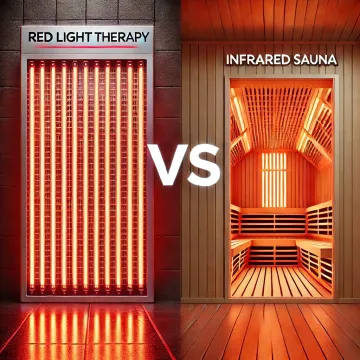So many people ask questions like:
"Will red light therapy fade tattoos?"
"Is red light therapy safe for tattoos?"
"What about the red light therapy tattoo healing combination!?"
Hence, I decided to write a short article about this topic! The good thing is, if you've recently got a tattoo, or about to get one, or had one in the past, red light therapy is not only safe but likely helpful!
Let's start with the good news: red light therapy doesn't fade tattoos, unlike sunlight. Red light therapy can also help you big time, by improving skin quality in the months before you're getting a tattoo and the recovery afterwards - I recommend using a superficial tissue dosing protocol for that, which is laid out in the full text.
Nevertheless, from an overall health perspective tattoos aren't without risk, and I'm not talking just about infections when you're getting them. Tattoos often contain heavy metals which can alter the dynamics light has on your skin, can cause allergic reactions and chronic inflammation, among others. So as a health professional, I tell people not to get tattoos unless they have to, such as to cover up a skin condition such as atopic dermatitis or psoriasis.
Right now, there's no direct research on red light therapy for tattoos. But, red light therapy has tons of proven skin health benefits, such as lowering inflammation and wound healing times, and improving collagen and elastin levels, which should help you before getting a tattoo or while recovering from getting one!
What Is Red Light Therapy
So, red light therapy uses red and near-infrared light that's projected onto your body and enters your skin. There, at the cellular level, the light makes your cells work more efficiently. With more efficient cells - such as through the powerhouses of your cells, the mitochondria - you generally move towards a healthier state (1; 2; 3; 4; 5).
That same red and near-infrared light is emitted by the sun. But, unlike the sun, which also emits ultraviolet light and all the colors of the rainbow (visible light), red light therapy mainly focuses on the red and near-infrared part.
That red and near-infrared light have the benefit of penetrating deeper into your skin. If you're curious about the basics of this topic, please consider a few articles me and others have written about it here:
- What Is Red Light Therapy?
- How To Use Red Light Therapy 101: The Best Guide For Starters
- The Power Of Red Light Therapy On Mitochondria
- Red Light Therapy For Skin: Beauty Benefits, Potential Complications, And More
I do want to especially focus on that last topic regarding skin health benefits:
Benefits Of Red Light Therapy For Tattoos
So, the big benefit of red light therapy is that it has a great positive effect on wound healing (6; 7; 8). Depending on the study you quote, healing speed may improve 50 - 100%.
Tattoos are really traumatic for your skin. There are loads of different problems that can arise by getting a tattoo (9; 10; 11; 12; 13; 14). Viral infections are an example here, skin complications, or skin hypersensitivity after getting a tattoo (9; 10; 11). Inks also contain toxins generally that can cause problems (12). Skin cancers can even arise from tattoos, especially red ink, but it's not 100% clear yet whether tattoos themselves cause this issue (13).
Generally, if you value your health, I wouldn't recommend getting tattoos. Here's what a recent review that analyzes and integrates earlier evidence on this topic states about tattoos and their toxicology risk:
"Tattooists, with the help of tiny needles, place tattoo ink inside the skin surface and unintentionally introduce a large number of unknown ingredients. These ingredients include polycyclic aromatic hydrocarbons (PAHs), heavy metals, and primary aromatic amines (PAAs), which are either unintentionally introduced along with the ink or produced inside the skin by different types of processes for example cleavage, metabolism and photodecomposition. These could pose toxicological risks to human health, if present beyond permissible limits. PAH such as Benzo(a)pyrene is present in carbon black ink. PAAs could be formed inside the skin as a result of reductive cleavage of organic azo dyes. They are reported to be highly carcinogenic by environmental protection agencies. Heavy metals, namely, cadmium, lead, mercury, antimony, beryllium, and arsenic are responsible for cancer, neurodegenerative diseases, cardiovascular, gastrointestinal, lungs, kidneys, liver, endocrine, and bone diseases. Mercury, cobalt sulphate, other soluble cobalt salts, and carbon black are in Group 2B, which means they may cause cancer in humans. Cadmium and compounds of cadmium, on the other hand, are in Group 1 (carcinogenic to humans)." (12)
No bueno! So my recommendation is to avoid tattoos at all costs. But if you do get a tattoo, you may as well counter the side effects and improve skin healing.
You can also precondition the skin as protection before you getting a tattoo. In that case, you'll probably have to use red light therapy for several weeks for the best benefits. Why? Well, in most studies, the benefits of red light therapy for skin health keep on improving over a few months. If you're curious about that topic, check the video below - where Alex Fergus, the founder of this website, explains mask studies:
Now, the thing is, there are no direct studies investigating red light therapy for tattoos. So you and I don't know the precise answer here, of how red light therapy would affect tattoos. But, most likely, the dynamic in the skin is the same as in skin beauty studies.
The mask studies covered above are the best proxy for that dynamic. Hence, given that the results keep increasing until 3 months after you've started the therapy in mask studies, it's most likely that the same is true for skin masks as well.
Let's explore that concept in more detail, though:
Are Tattoos And Red Light Therapy A Benign Combination Or Not?
So, yes, red light therapy and tattoos are somewhat of a unique combination. Because red light therapy lowers problems you may have with skin health if it's applied before and after getting a new tattoo.
Red light therapy shouldn't affect existing tattoos too much if at all, however. There are some counterarguments against that thesis, however, from Dr. Jack Kruse who I've considered before in my article about melasma and light therapy.
Dr. Kruse considers anything artificial on the skin potentially problematic if it changes the light dynamic (15). As stated in the quote above, tattoos contain toxic heavy metals (12). Metals interact with light, and may therefore change how the light hitting your skin affects your body's biology.
I've very extensively talked about how the melanin system doesn't just affect the skin but is found in many other locations in the body, such as the nervous system and the brain. Red and near-infrared light affect the melanin system, as does ultraviolet and blue light.
Hence, tattoos may throw off that dynamic! There's very little direct research on this topic directly, right now. But theoretically, the implications can be huge. Covering up your skin with a tattoo may be like covering up a solar panel with a canopy - the function will be impeded!
So let's go back to Dr. Kruse. Dr. Kruse has often stated that the transition metals in tattoos will interfere with light hitting your skin (16; 17). Even though there are no direct medical studies on this topic, from the more foundational science of physics, this conclusion is 100% logical.
Metals may also have a secondary effect, which is changing the electromagnetic properties of the skin. As a result, you may have altered dynamics concerning Electro-Magnetic Frequencies (EMFs) in your environment, such as radio waves and magnetic fields. This conclusion is universally true for metals in the body - that's why biological dentists tend to avoid titanium implants in favor of ceramic ones, for instance.
All of these changes may affect your health on the cellular level in the long run. Hence, from a health perspective, I don't recommend people get tattoos and avoid them! And if you do get a tattoo, hopefully, you're informed about the consequences now.
So let's get back to red light therapy:
So, Red Light Therapy: Before, After, Or Not At All for Tattoos?
If you're going to get a tattoo anyway, use red light therapy a few months before and after getting a tattoo. Again, the best option for health is arguably not getting a tattoo at all, but fortunately, people are free in their choices!
People do all kinds of nasty stuff for their health, and I've done unhealthy things in the past, so who am I to judge here? If you get a tattoo, use the dosing protocols for superficial tissues. Read my dosing article for more details - where I suggest a maximum total dose of 8 - 10 J/cm2. That article helps you calculate the dose with different devices as well!
That protocol will optimize skin health before or after getting a tattoo. If you're out of the running anyway, you may as well do it correctly. The light will even penetrate through thin plastic, which you may have to wear after getting a tattoo. Of course, do follow the advice of your tattoo artist regarding light exposure.
You'll also have to be very careful with sunlight and fresh tattoos. But you're probably aware of that, as any tattoo artist will inform you about that risk! However, it's not the tattoo that's at risk for damage! The tattoo is only at risk for fading over time. The inflammation in the skin is the problem after you've just gotten a new tattoo - and that's where red light shines!
Dermatology's Opinion On Tattoos
Yes, I hate to be the bearer of bad news! Even in dermatology, there's some skepticism towards tattoos. When you look at scientific publications on thet topic, tattoos can aggravate existing skin conditions, create new ones, and have complications (18; 19; 20; 21; 22; 23).
Real immediate complications of tattoos are rare, fortunately (18). Please keep in mind that not all tattoos are for cosmetic purposes–some are for dermatological corrections such as when skin issues are present. So it's not always 100% avoidable for anyone to get a tattoo, unfortunately.
Side effects can also start years after you get a tattoo (19). Examples here are chronic inflammation and allergies (19). These side effects can eventually affect organs other than the skin! Theoretically, you can increase your cancer risk with tattoos, affect organ function such as your liver and kidneys, and more.
And, yes, in some cases, you may want to get a tattoo, such as psoriasis or atopic dermatitis (21). Even then, however, I would exhaust all your options first before covering up the skin with a tattoo.
The good news?
Tattoo removal is improving dramatically (22). I've seen some of these machines myself when at light therapy conferences! Lasers can often help you remove tattoos, and with fewer and fewer side effects. So tattoos no longer have to be considered permanent, unlike 20 years ago!
Can Red Light Therapy Fade Tattoos?
Finally, some good news! Red light therapy won't fade tattoos! So you should be safe here!
Other types of light, such as ultraviolet light, may fade tattoos over time. The same is valid for heating! So this doesn't mean you can be out in the sun without consequences.
Hence, red light therapy is a great solution here as it allows you to get the light exposure without fading your tattoos. Nevertheless, I do think that overall sunlight exposure, including ultraviolet light, is essential for overall health. Hence, I don't recommend avoiding sunlight exposure to keep your tattoos from fading!
Nevertheless, don't be worried about red light therapy fading your tattoo. So that's great for finally a positive message!
Lastly:
Exploring Red Light Therapy Beyond Tattoos
Next to the question of "is red light therapy bad for tattoos", there's a whole different discussion about skin health in general. Here, I want to pinpoint you to articles I've written in the past - or by other team members of this website:
- Red Light Therapy For Face Before And After: Unbelievable Results!
- Red Light Therapy For Sunburn: Prevention and Treatment
- Red Light Therapy For Skin: Beauty Benefits, Potential Complications, And More
- Does Red Light Therapy Help Scars? The Science
- Red Light Therapy Mask Science: Everything You Need To Know
- LED Mask Vs Red Light Therapy Panel: Which Is Best?
Whether it's for the collagen or elastin in the skin, or redness, or scar tissue, tons of different red light therapy skin benefits exist! So, despite red light therapy not really influencing your tattoos and helping recovery when you're getting a new one, it's still recommended to use it for overall skin health and beauty!
So, red light therapy is a win-win! Finally, let's conclude:
Conclusion: Praise The Red Light Therapy Tattoo Healing Advantage!
The answer to "does red light therapy affect tattoos" is "barely!" And that's great news, especially given that you can use red light therapy to optimize skin health before and after getting a new tattoo.
Hopefully, you've also read that I'm a bit skeptical against getting tattoos from a holistic health perspective. I just want to state the truth here and sometimes I'd want reality to be different too. I wish I could get tattoos myself without health consequences, in the same way I wish lots of other unhealthy stuff without consequence! But that's not reality...
I hope, though, that this article helps you navigate the topic better! Great luck!
This is a post by Bart Wolbers. Bart finished degrees in Physical Therapy (B), Philosophy (BA and MA), Philosophy of Science and Technology (MS - with distinction), and Clinical Health Science (MS), has had training in functional medicine, and is currently chief science writer at Lighttherapyinsiders.com
Found This Interesting? Then You Might Like:
- Start Here - Light Therapy 101 & Buyers Guide
- What Is Red Light Therapy?
- Discount Codes, Deals & Recommendations - Red Light Therapy
- Red Light Therapy Dosing Chart: The Raw Data From Hundreds Of Studies
- Red Light Therapy Dosing: Why It's Complicated!
- Red Light Therapy Wavelengths Benefits: The Ultimate Guide
- Red Light Therapy Vs Infrared Sauna: Everything You Need To Know!









